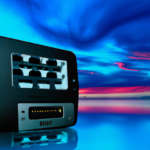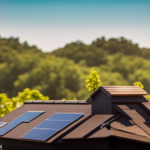Tiny Houses
How Do Power Work in a Tiny House

As a tiny house enthusiast, I’ve come to realize that power in these compact dwellings is like a well-oiled machine.
It’s all about understanding the electrical system, harnessing solar power, and maximizing energy usage with efficient appliances.
Whether you’re looking to go off-grid or stay connected to the main power supply, this article will guide you through the ins and outs of how power works in a tiny house.
So let’s dive in and shed light on this electrifying topic!

Key Takeaways
- Understanding power consumption and calculating the power consumption of each appliance is crucial in a tiny house.
- Solar power can be a clean and renewable source of energy for a tiny house, significantly lowering electricity bills.
- Battery storage allows for storing excess solar power for later use, ensuring a reliable source of electricity when the sun isn’t shining.
- Maximizing power usage with energy-efficient appliances and practicing smart power management techniques can help optimize power usage in a tiny house.
Understanding the Electrical System
I can’t rely on just one source of power in a tiny house; I need to understand how the electrical system works.
Understanding power consumption is crucial in ensuring that I’ve enough electricity to meet my needs. It involves calculating the amount of power each appliance or device consumes and making sure that my power supply can handle the load.
Additionally, I must take electrical safety precautions to protect myself and others. This includes using proper wiring, installing circuit breakers, and grounding the system. It’s important to be aware of potential hazards, such as overloaded circuits, exposed wires, and faulty electrical equipment.
Solar Power: Harnessing the Sun’s Energy
One of the most popular ways to generate electricity in a tiny house is by harnessing the sun’s energy through solar power. Solar panels, made up of photovoltaic cells, convert sunlight into electricity. The installation of solar panels involves mounting them on the roof or in an area with maximum sun exposure. This ensures optimal energy production.
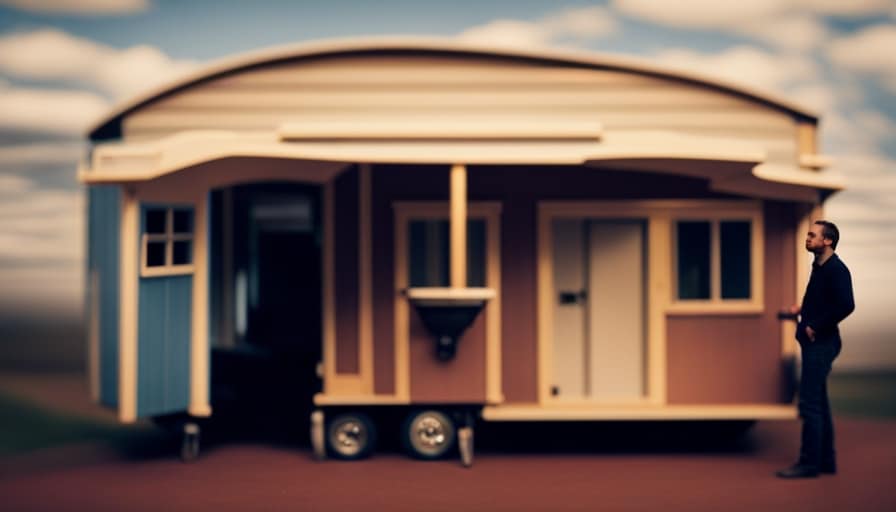
The benefits of solar power in a tiny house are numerous. Firstly, it provides a clean and renewable source of energy, reducing dependence on fossil fuels. Secondly, it can significantly lower electricity bills as the sun’s energy is free. Lastly, solar power systems require minimal maintenance and have a long lifespan.
Transitioning to the next section, battery storage allows for the storage of excess solar power for later use.
Battery Storage: Storing Power for Later Use
The battery storage system allows me to store excess power generated from solar panels for later use. This is a crucial component of power management in my tiny house, as it ensures that I have a reliable source of electricity even when the sun isn’t shining.
By utilizing alternative energy sources such as solar power and storing the excess energy in batteries, I am able to minimize my reliance on the grid and reduce my carbon footprint.
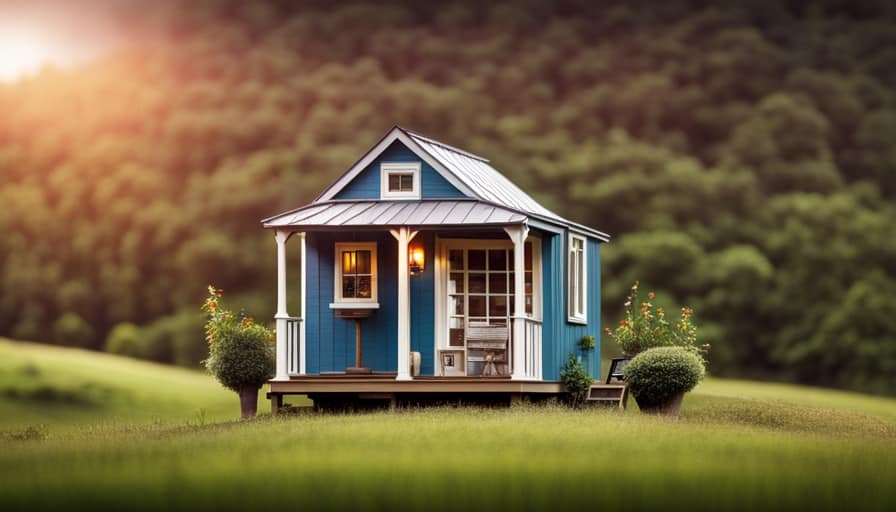
The battery storage system enables me to have power during nighttime or cloudy days, providing a consistent and uninterrupted supply of electricity.
With this power management solution in place, I can now transition into discussing the next section, which focuses on energy-efficient appliances and maximizing power usage in my tiny house.
Energy-efficient Appliances: Maximizing Power Usage
Using energy-efficient appliances is key to maximizing power usage in my tiny house. By choosing appliances that are designed to consume less energy, I can reduce my overall power consumption and save on electricity bills. Energy-saving tips include selecting appliances with the ENERGY STAR label, which indicates that they meet strict energy efficiency guidelines.
Additionally, I can utilize smart power management techniques to further optimize power usage. This includes using power strips with built-in timers or energy monitors to track and control the power consumption of various appliances. By being mindful of my energy usage and making smart choices, I can ensure that I maximize the power available in my tiny house while minimizing waste.
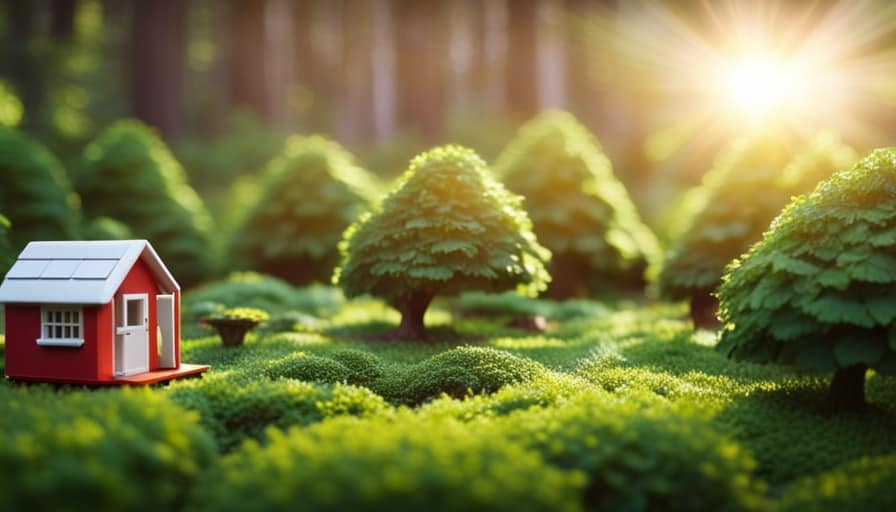
Transitioning to the next section, let’s now explore the different power options for tiny houses: off-grid vs. on-grid power.
Off-Grid Vs. On-Grid Power Options
I prefer using off-grid power options in my tiny house because they allow me to be self-sufficient and not rely on the traditional power grid. Here are the pros and cons of off-grid and on-grid power installations:
Off-Grid Power:
Pros:
- Independence: With off-grid power, I’ve complete control over my energy production and consumption.
- Sustainability: I can use renewable energy sources like solar panels or wind turbines, reducing my carbon footprint.
- Cost savings: By generating my own power, I can save money on monthly utility bills.
- Flexibility: Off-grid power allows me to live in remote locations without access to the main power grid.
Cons:
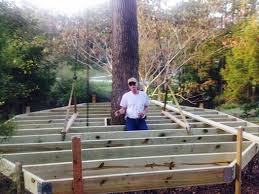
- Initial investment: Setting up an off-grid power system can be expensive due to the cost of solar panels, batteries, and other equipment.
- Limited power supply: Depending on the system size, off-grid power may have limitations in terms of the amount of energy it can generate and store.
- Maintenance: Off-grid systems require regular maintenance to ensure optimal performance.
Considering these factors, off-grid power options offer me the freedom, sustainability, and cost savings that align with my desire for self-sufficiency in my tiny house.
Frequently Asked Questions
How Much Does It Cost to Install a Solar Power System in a Tiny House?
Installing a solar power system in a tiny house can cost anywhere from $2,000 to $10,000, depending on the size and complexity of the system. A cost comparison and benefits analysis can help determine the best option.
Can I Connect My Tiny House to the Main Power Grid if I Choose an Off-Grid Power Option?
If I choose an off-grid power option for my tiny house, I cannot directly connect it to the main power grid. However, there are pros and cons to both options, and it’s important to consider factors like cost and sustainability.
What Are the Maintenance Requirements for Solar Panels in a Tiny House?
Maintenance requirements for solar panels in a tiny house include regular cleaning to remove dust and debris, checking for any damage or loose connections, and monitoring the performance of the panels. The benefits of proper maintenance include improved energy efficiency and prolonged lifespan.
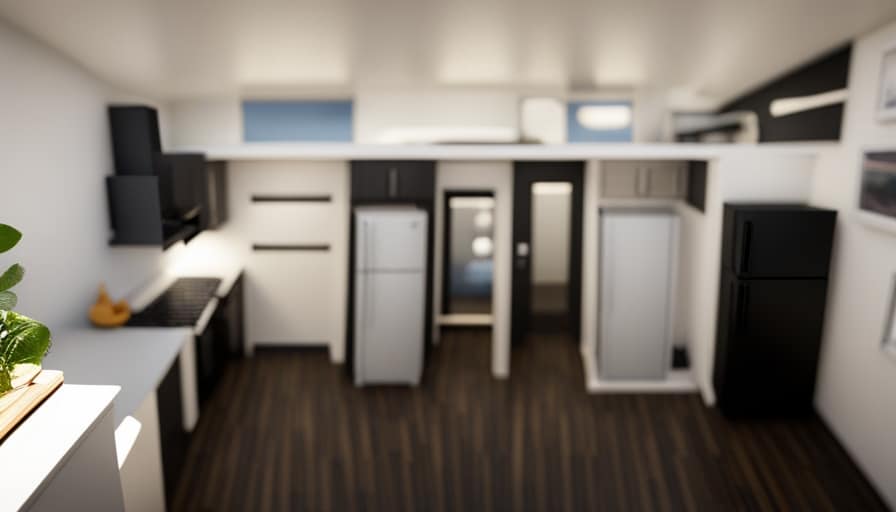
How Long Can a Battery Storage System Power a Tiny House Before It Needs to Be Recharged?
The battery lifespan of a tiny house’s power storage system depends on various factors such as the size of the battery and the energy consumption. However, alternative power sources can also be used to recharge the battery when needed.
Are There Any Government Incentives or Tax Credits Available for Installing Renewable Energy Systems in a Tiny House?
There are government incentives and tax credits available for installing renewable energy systems in a tiny house. These incentives and credits can help offset the costs of the equipment and installation.
Conclusion
After delving into the intricate workings of power in a tiny house, it becomes clear that the electrical system is the heart of it all. By harnessing the sun’s energy through solar power and storing it in batteries, one can achieve a self-sufficient and eco-friendly lifestyle.
Opting for energy-efficient appliances further maximizes power usage, making every kilowatt count. Whether choosing off-grid or on-grid power options, the key lies in understanding and utilizing the intricate mechanisms that power our humble abodes.
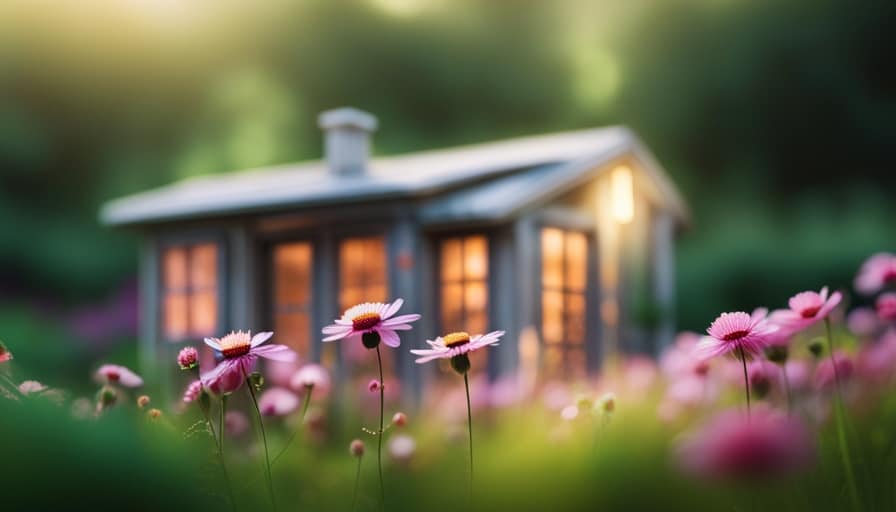
I’m Theodore, and I love tiny houses. In fact, I’m the author of Tiny House 43, a book about tiny houses that are also tree houses. I think they’re magical places where imaginations can run wild and adventures are just waiting to happen.
While tree houses are often associated with childhood, they can be the perfect adult retreat. They offer a cozy space to relax and unwind, surrounded by nature. And since they’re typically built on stilts or raised platforms, they offer stunning views that traditional homes simply can’t match.
If you’re looking for a unique and romantic getaway, a tree house tiny house might just be the perfect option.
Tiny Houses
10 Key Elements for a Functional Tiny House Design

Are you prepared to discover the mysteries of efficient tiny house design? We have everything you need.
In this article, we’ll delve into the ten key elements that make a tiny house truly livable. From efficient use of space to clever storage solutions, we’ll explore every nook and cranny to help you maximize your living area.
With our expert tips and tricks, you’ll be able to create a tiny house that’s not only practical, but also stylish and comfortable.
Let’s dive in and transform your tiny house dreams into a reality.
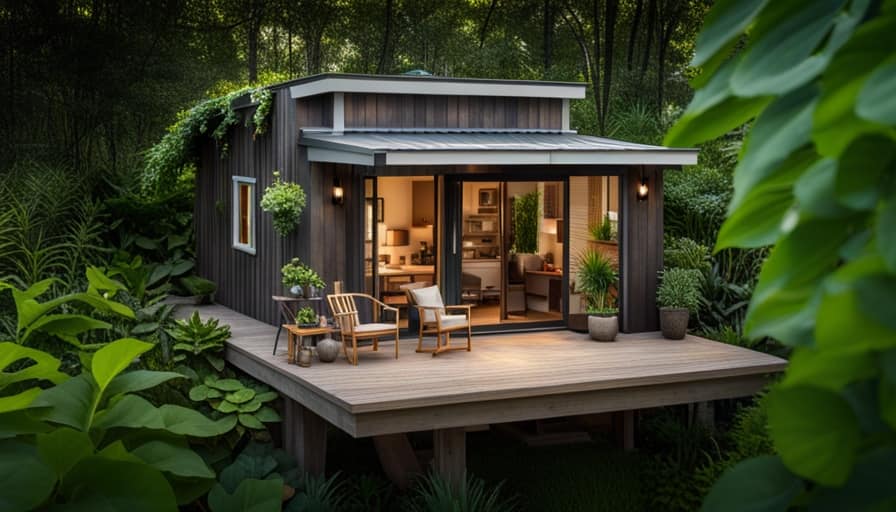
Key Takeaways
- Efficient use of space is crucial in a functional tiny house design, with clever storage solutions and multi-purpose furniture being essential.
- Optimizing natural light and having an effective ventilation system are important for creating a comfortable and healthy living environment in a tiny house.
- The design elements of the kitchen and bathroom should prioritize functionality and efficiency, while integrating smart technology can enhance the overall functionality of the tiny house.
- Sustainable energy solutions, outdoor living spaces, and maximizing small yards are key considerations for creating a sustainable and enjoyable living experience in a tiny house.
Efficient Use of Space
We can maximize the utilization of space in our tiny house design by incorporating smart storage solutions.
Efficient organization and innovative space-saving techniques are crucial in creating a functional and comfortable living environment.
One way to achieve efficient organization is by utilizing multi-functional furniture that serves multiple purposes, such as a sofa that can also be used as a storage unit.
Another innovative space-saving idea is to utilize vertical space by installing floating shelves or wall-mounted storage units.
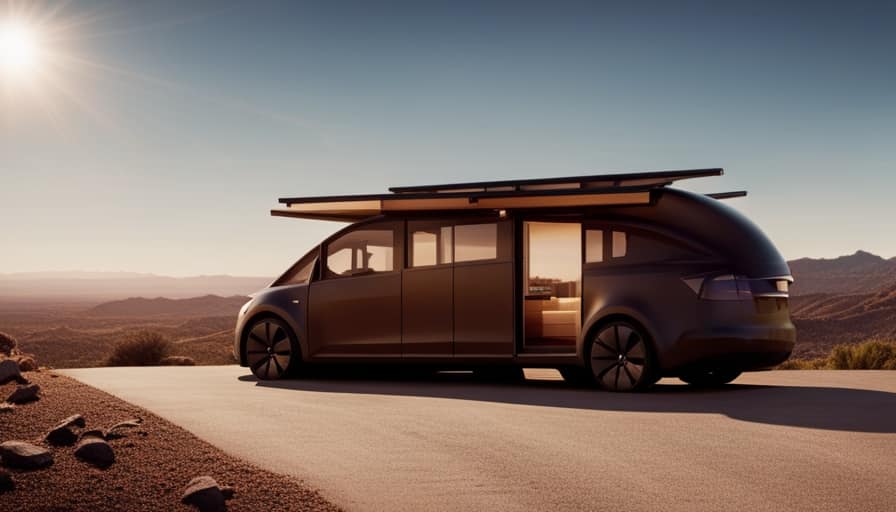
Additionally, incorporating built-in storage solutions, such as hidden compartments or under-the-stairs storage, can help optimize space utilization.
Clever Storage Solutions
To optimize storage in our tiny house design, we can use clever solutions such as utilizing vertical space and incorporating hidden compartments. By thinking creatively, we can maximize the functionality of our limited square footage. One way to achieve this is through the use of hidden compartments, which allow for discreet storage without sacrificing aesthetics. Additionally, creative shelving solutions can help us make the most of every nook and cranny. To illustrate these ideas, consider the following table:
| Solution | Description | Benefits |
|---|---|---|
| Vertical shelving | Utilize wall space for storage | Saves floor space |
| Under-bed storage | Utilize empty space under the bed | Maximize storage in small areas |
| Hidden wall compartments | Concealed storage within walls | Provides a sleek and clutter-free look |
Multi-purpose Furniture
When it comes to designing a functional tiny house, one of the key elements to consider is multi-purpose furniture. This type of furniture offers space-saving solutions by serving multiple functions.
From sofas that can transform into beds to coffee tables with hidden storage compartments, versatile furniture options allow you to maximize functionality without sacrificing style.

Space-Saving Solutions
Our tiny house design incorporates several space-saving solutions, such as using multi-purpose furniture. We understand the importance of maximizing every square inch in a small living space, and that’s why we’ve incorporated innovative ideas to provide functionality without compromising on style.
Here are some space-saving solutions we’ve implemented in our tiny house design:
-
Foldable furniture: Our design includes foldable tables, chairs, and beds that can be easily stowed away when not in use, creating more floor space and allowing for flexible room configurations.
-
Hidden storage: We’ve integrated clever storage solutions throughout the house, utilizing hidden compartments under stairs, within walls, and even under the floor. These hidden storage spaces provide ample room to store belongings, keeping the living areas clutter-free and organized.

Versatile Furniture Options
The tiny house design incorporates versatile furniture options and multi-purpose furniture. When space is limited, it’s crucial to maximize functionality without sacrificing comfort.
Transformable seating is a key element in achieving this goal. By day, a sofa can provide a cozy spot to relax or entertain guests. However, with a simple adjustment, it can be transformed into a comfortable bed for a good night’s sleep.
Additionally, convertible storage is essential in tiny house living. Furniture pieces with hidden compartments or built-in storage solutions allow for efficient organization and help keep clutter at bay.
These versatile furniture options not only save space but also enhance the overall functionality of the tiny house design.
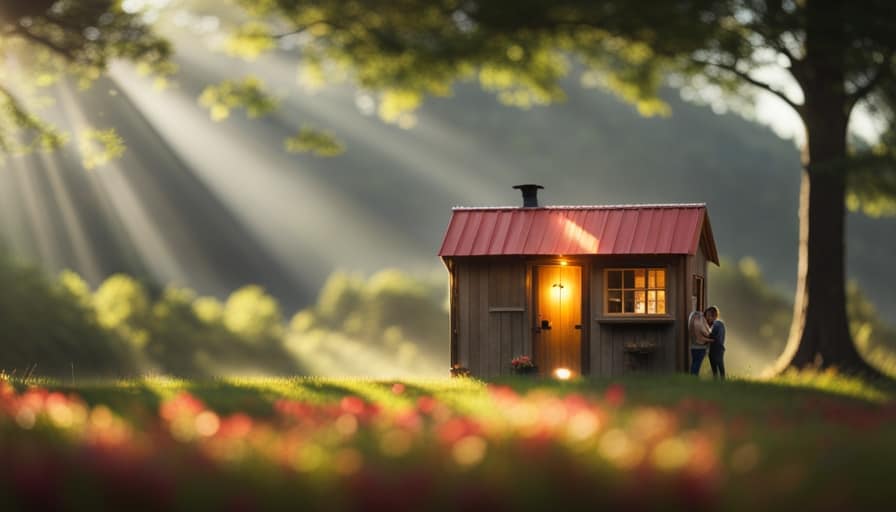
Now, let’s explore how we can further maximize functionality with design…
Maximizing Functionality With Design
As we continue our exploration of maximizing functionality with design, let’s delve into the versatility and practicality of multi-purpose furniture.
When it comes to tiny house living, every square inch matters, and maximizing efficiency is key. Multi-purpose furniture offers a solution by combining multiple functionalities into a single piece, allowing you to make the most of your limited space.
Here are some examples of how multi-purpose furniture can enhance your tiny house design:
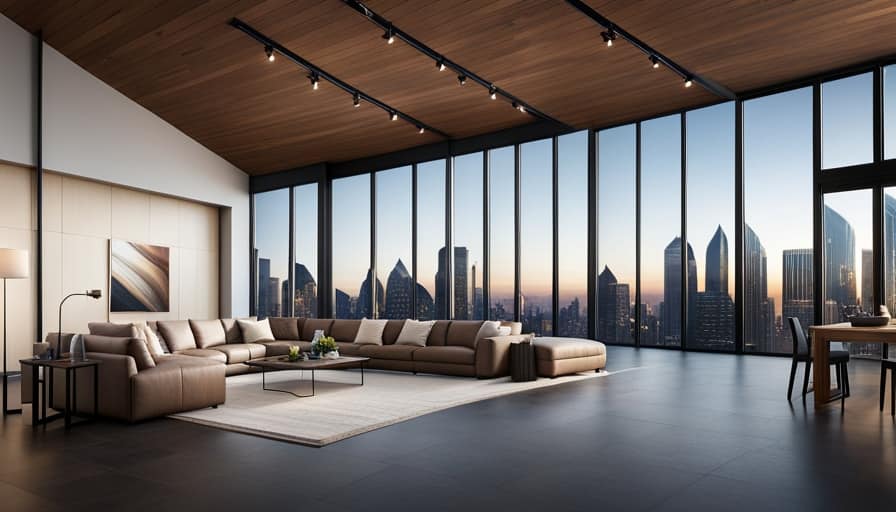
- Convertible sofa beds that serve as seating during the day and transform into a comfortable sleeping space at night.
- Folding dining tables that can be expanded when needed and folded away when not in use.
By incorporating these ergonomic design elements into your tiny house, you can create a functional and comfortable living space.
Now, let’s move on to the next topic of optimizing natural light.
Optimizing Natural Light
We can maximize natural light in our tiny house by strategically placing windows and using reflective surfaces. Natural light optimization is crucial for creating a bright and welcoming living space.
When designing our tiny house, we should consider the orientation of the windows to capture the most sunlight throughout the day. Placing windows on the south-facing side will allow for maximum exposure to sunlight, especially during the winter months.
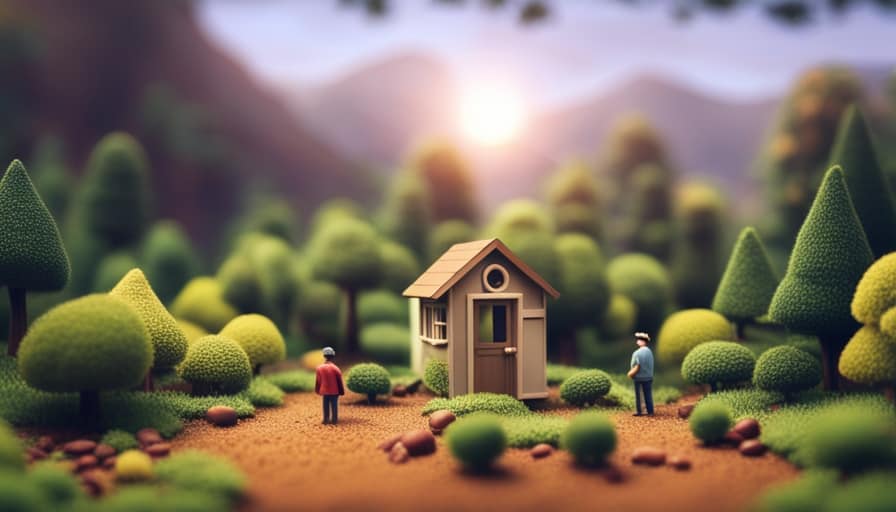
Additionally, incorporating reflective surfaces such as mirrors or light-colored walls can help bounce natural light around the space, making it feel larger and more open.
It’s important to note that while natural light is ideal, we should also consider energy-efficient lighting options for the evenings or on cloudy days. LED lights are a great choice as they’re energy-saving and long-lasting, ensuring we can enjoy a well-lit space while minimizing our environmental impact.
Effective Ventilation System
But, in order to ensure a comfortable and healthy living environment, we must also prioritize an effective ventilation system. Efficient air circulation and temperature control are key components of a well-designed tiny house.
Here are some reasons why a robust ventilation system is crucial:
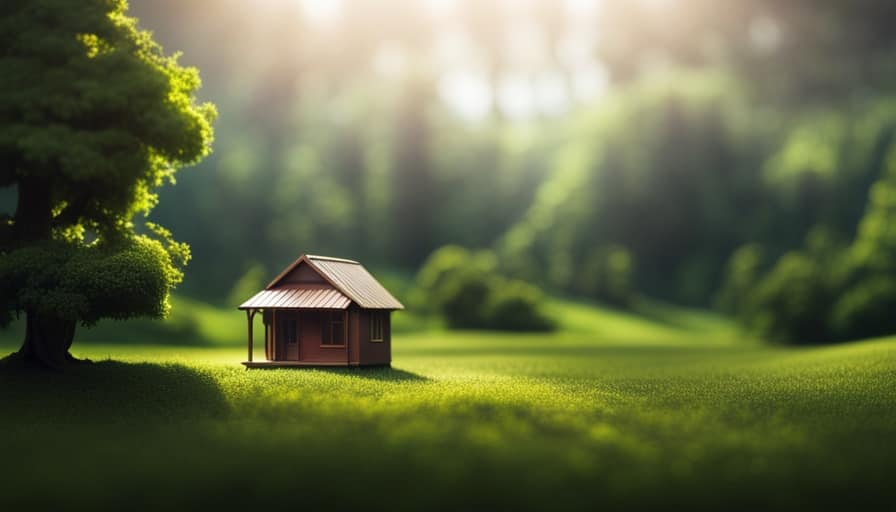
-
Improved air quality: A proper ventilation system helps remove stale air, odors, and pollutants, ensuring a constant supply of fresh air. This is especially important in a small space where air can quickly become stagnant.
-
Prevention of condensation: Adequate ventilation helps control humidity levels, preventing condensation on windows and walls. This reduces the risk of mold and mildew growth, which can lead to respiratory issues.
-
Regulation of temperature: A well-ventilated tiny house can help maintain a comfortable indoor temperature by allowing hot air to escape during the summer and retaining warmth during the winter.
Functional Kitchen Design
The functional kitchen design is an essential aspect of creating a practical and efficient tiny house. In order to maximize space and functionality, it’s important to incorporate efficient appliances and a minimalist design.
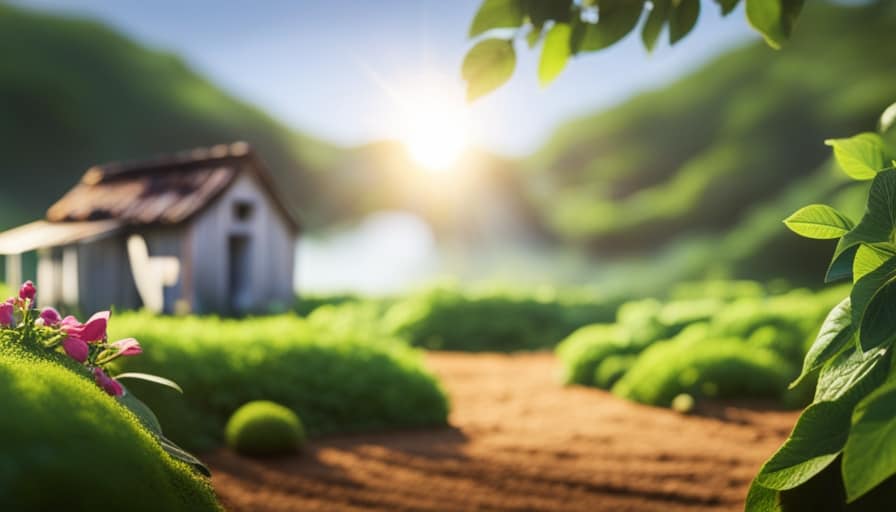
When choosing appliances, opt for compact and energy-efficient models that can perform multiple functions. This will help save space and reduce energy consumption.
Additionally, a minimalist design approach can create a clean and organized kitchen area. Utilize clever storage solutions, such as built-in cabinets and pull-out drawers, to maximize storage space. Consider using multipurpose furniture, like a kitchen island with built-in storage, to serve multiple functions.
Well-designed Bathroom Layout
With careful planning and attention to detail, a well-designed bathroom layout can maximize space and functionality in a tiny house. When it comes to creating an efficient plumbing system and optimizing a small bathroom design, there are a few key elements to consider:
- Space-saving fixtures: Opt for compact toilets, corner sinks, and wall-mounted faucets to save valuable space in the bathroom.
- Smart storage solutions: Utilize vertical space by installing shelves or cabinets above the toilet or sink. Consider using recessed shelving or built-in niches to maximize storage while keeping the bathroom visually uncluttered.
- Multi-functional design: Incorporate dual-purpose elements like a mirror cabinet that can also serve as additional storage or a folding shower seat that can be tucked away when not in use.
- Creative layout: Experiment with unconventional layouts, such as placing the shower at the end of the bathroom or utilizing sliding doors to save space.
- Natural light and ventilation: Install windows or skylights to bring in natural light and fresh air, creating a sense of openness and preventing moisture buildup.
Smart Technology Integration
We can enhance the functionality and convenience of a tiny house by integrating smart technology into its design.
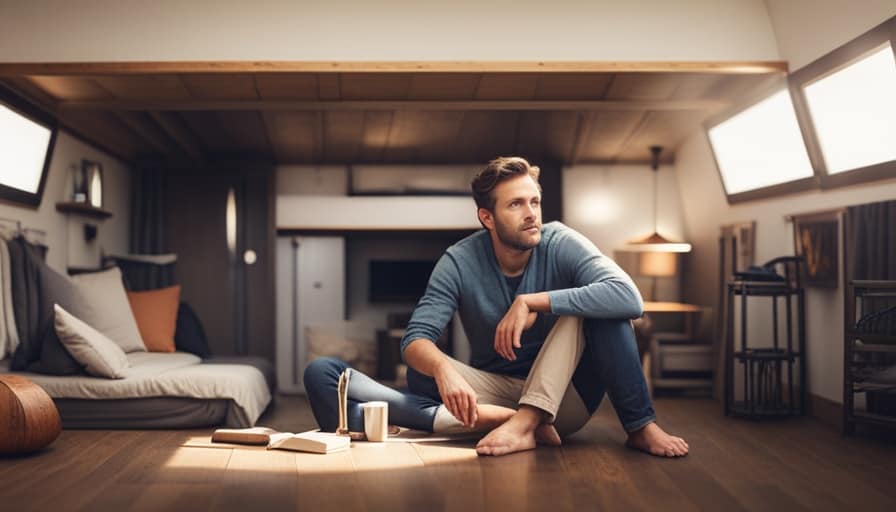
Smart home automation allows us to control various aspects of the house using our smartphones or voice commands. By connecting devices such as lights, thermostats, and security systems to a central hub, we can easily manage and monitor them remotely. This level of automation not only improves the efficiency of the house but also adds a layer of convenience to our daily lives.
In addition to smart home automation, energy efficient appliances play a crucial role in a tiny house. By using appliances that are designed to consume less energy, we can reduce our environmental footprint and save on utility bills.
Transitioning into the subsequent section about sustainable energy solutions, we can explore how these technologies can further optimize the energy usage in a tiny house.
Sustainable Energy Solutions
Our goal is to implement renewable energy sources in order to create a sustainable and eco-friendly energy solution for our tiny house. By incorporating solar power, we can harness the natural energy from the sun to power our home. This not only reduces our reliance on non-renewable resources but also helps to lower our carbon footprint.
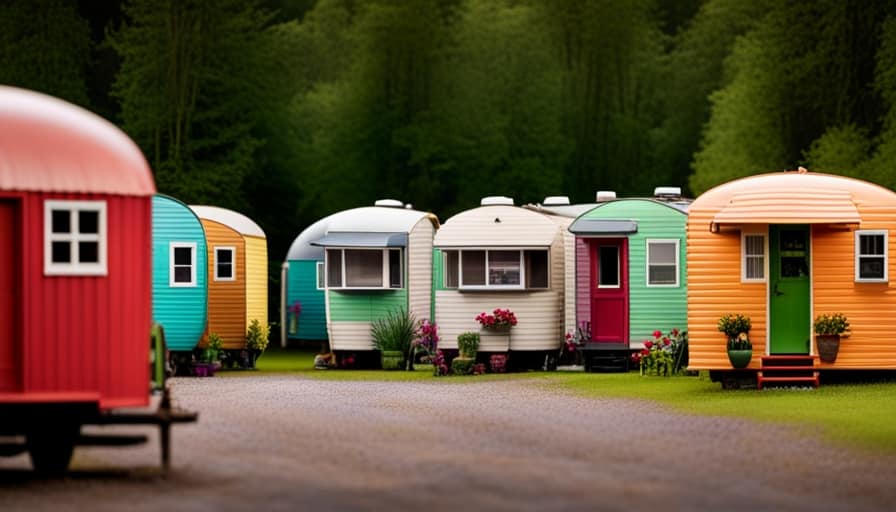
In addition, we plan to use energy efficient appliances throughout our tiny house. These appliances are designed to consume less electricity, which not only saves energy but also reduces our utility bills.
With the combination of solar power and energy efficient appliances, we can create a self-sufficient and environmentally friendly energy solution for our tiny house, making it a truly sustainable living space.
Outdoor Living Spaces
When designing outdoor living spaces for a tiny house, we must focus on maximizing the small yard. This can be achieved by using vertical gardening techniques, such as trellises and hanging planters, to make the most of limited space.
Another crucial element is versatile outdoor furniture that can serve multiple purposes, such as folding tables and chairs that can be easily stored when not in use.
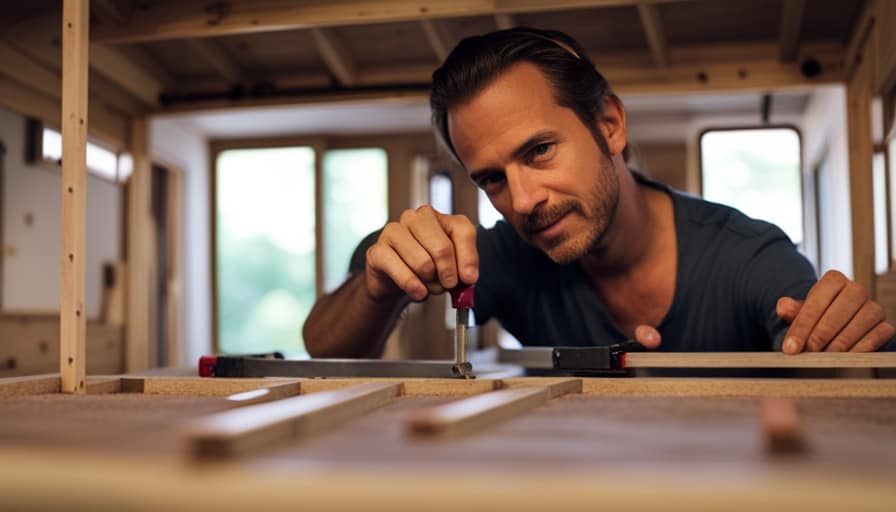
Lastly, an integrated cooking area with a compact grill or outdoor stove allows for convenient outdoor dining experiences without taking up too much space.
Maximize Small Yard
How can we make the most of our small yard to create functional outdoor living spaces in our tiny house design? With careful planning and creative thinking, there are several ways to maximize the potential of our limited outdoor space.
Here are some ideas to consider:
-
Create a small garden: Utilize vertical gardening techniques, hanging planters, and raised beds to make the most of the available space. Choose plants that are suitable for small gardens and require minimal maintenance.
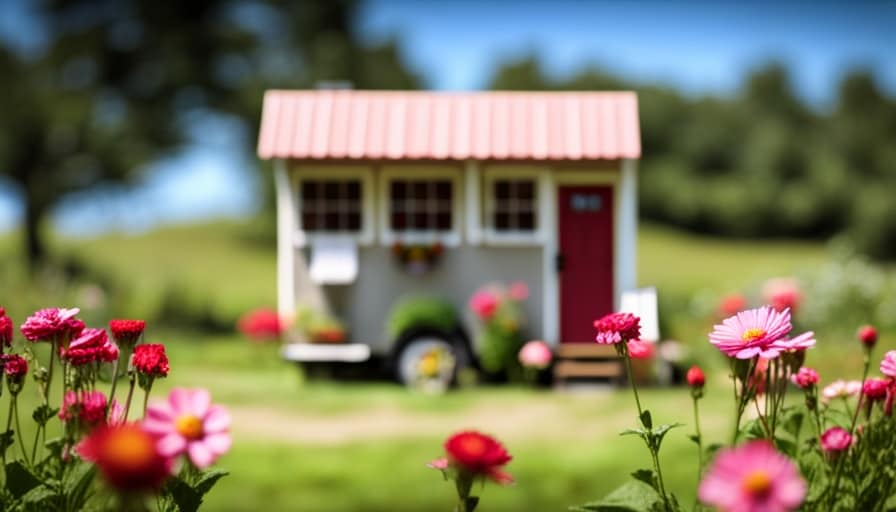
-
Design for outdoor activities: Incorporate features like a compact seating area, a small fire pit, or a mini outdoor kitchen to create a functional space for relaxation and entertaining. Consider using multipurpose furniture that can be easily folded or stacked to save space when not in use.
Versatile Outdoor Furniture
One option to consider for creating functional outdoor living spaces in our tiny house design is to incorporate versatile outdoor furniture, such as folding chairs and stackable tables. These types of furniture can easily be moved and rearranged to accommodate different activities and maximize the use of limited outdoor space.
Folding chairs are compact and can be stored away when not in use, while stackable tables can be stacked together to save space. Additionally, outdoor seating can be enhanced by using cushions and pillows that add comfort and style.
To create a cohesive and inviting outdoor living area, it’s important to also consider garden landscaping. Incorporating plants, flowers, and other natural elements can create a serene and relaxing environment that complements the versatile outdoor furniture.
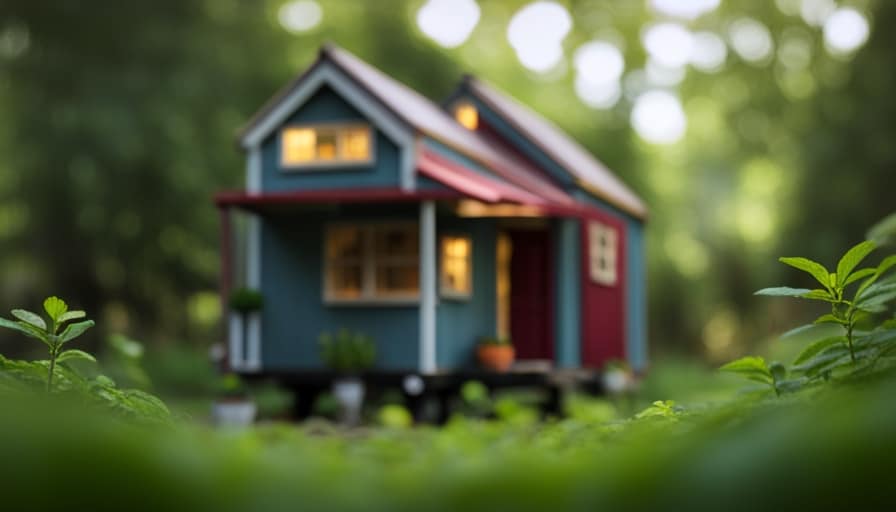
Integrated Cooking Area
We can create a functional outdoor living space in our tiny house design by incorporating an integrated cooking area. This allows us to enjoy the benefits of cooking and dining al fresco, while making the most of our limited space.
To achieve this, we should consider the following:
-
Efficient layout: Design the cooking area with an ergonomic kitchen layout that maximizes functionality and minimizes wasted space. Consider the placement of appliances, work surfaces, and storage areas to create an efficient workflow.
-
Multi-purpose features: Incorporate multi-purpose features such as foldable countertops or convertible tables that can be used for food preparation, dining, and entertaining. This helps optimize the use of space and ensures versatility in our outdoor cooking area.

Frequently Asked Questions
What Are Some Tips for Maximizing Storage in a Tiny House?
To maximize storage in a tiny house, we recommend incorporating space-saving furniture and clever storage solutions. These include built-in shelves, hidden compartments, and multi-functional furniture pieces that serve multiple purposes while taking up minimal space.
How Can I Make the Most of Natural Light in a Small Space?
To maximize natural light in a small space, we strategically placed large windows on the south-facing wall of our tiny house. This design choice not only brightens the interior but also reduces the need for artificial lighting during the day.
What Are Some Innovative Ways to Incorporate Multi-Purpose Furniture Into a Tiny House Design?
Incorporating innovative furniture designs and space-saving solutions is essential in a well-designed tiny house. By maximizing functionality through multi-purpose furniture, we can optimize the limited space available and create a comfortable living environment.
Can You Provide Examples of Sustainable Energy Solutions for a Tiny House?
Off grid power solutions and sustainable water systems are crucial for a functional tiny house. We can explore solar panels, wind turbines, and rainwater harvesting as some examples. These sustainable energy solutions ensure self-sufficiency and minimal impact on the environment.
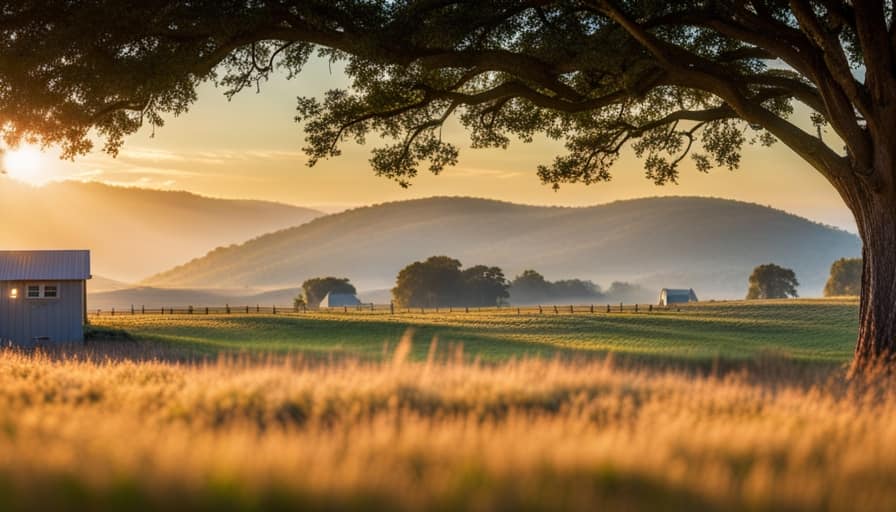
What Are Some Creative Ways to Incorporate Outdoor Living Spaces Into a Small Footprint?
We can creatively incorporate outdoor living spaces into a small footprint by utilizing outdoor seating options such as built-in benches or foldable furniture. Additionally, vertical gardening can provide a unique and space-saving way to bring greenery into the tiny house design.
Conclusion
In conclusion, a well-designed tiny house should prioritize efficient use of space, clever storage solutions, and multi-purpose furniture to maximize functionality.
Optimizing natural light and implementing an effective ventilation system are essential for a comfortable living environment.
A well-designed bathroom layout and the integration of smart technology can greatly enhance the overall experience.
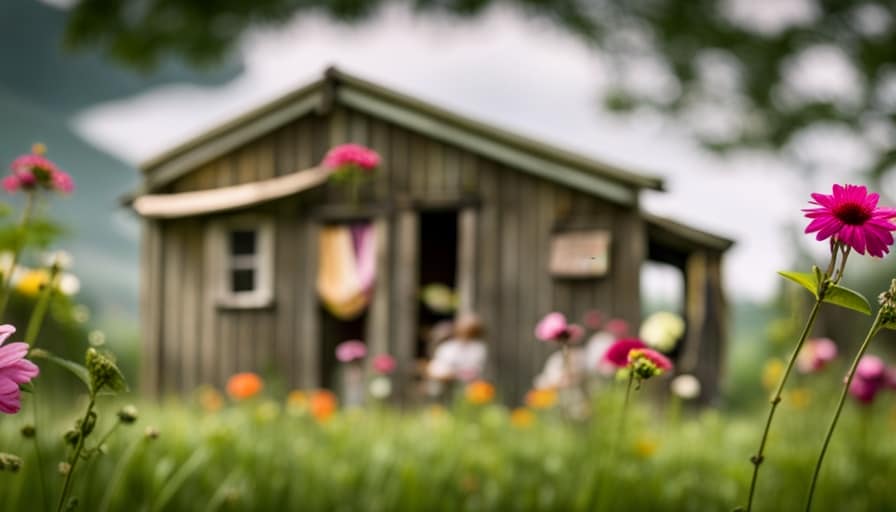
Sustainable energy solutions and outdoor living spaces provide a sense of connection with nature.
As the saying goes, ‘A tiny house with a big heart.’
I’m Theodore, and I love tiny houses. In fact, I’m the author of Tiny House 43, a book about tiny houses that are also tree houses. I think they’re magical places where imaginations can run wild and adventures are just waiting to happen.
While tree houses are often associated with childhood, they can be the perfect adult retreat. They offer a cozy space to relax and unwind, surrounded by nature. And since they’re typically built on stilts or raised platforms, they offer stunning views that traditional homes simply can’t match.
If you’re looking for a unique and romantic getaway, a tree house tiny house might just be the perfect option.
Tiny Houses
Brightening Your Compact Home: Mastering Tiny House Utilities

Are you aware that the average American household consumes approximately 10,649 kilowatt-hours of electricity annually? That’s quite a significant amount of power!
But what if you could brighten your compact home while using a fraction of that energy?
In this article, we’ll show you how to master the utilities in your tiny house, from choosing the right power source to setting up your water supply.
Get ready to create a comfortable and efficient living space that serves your needs.
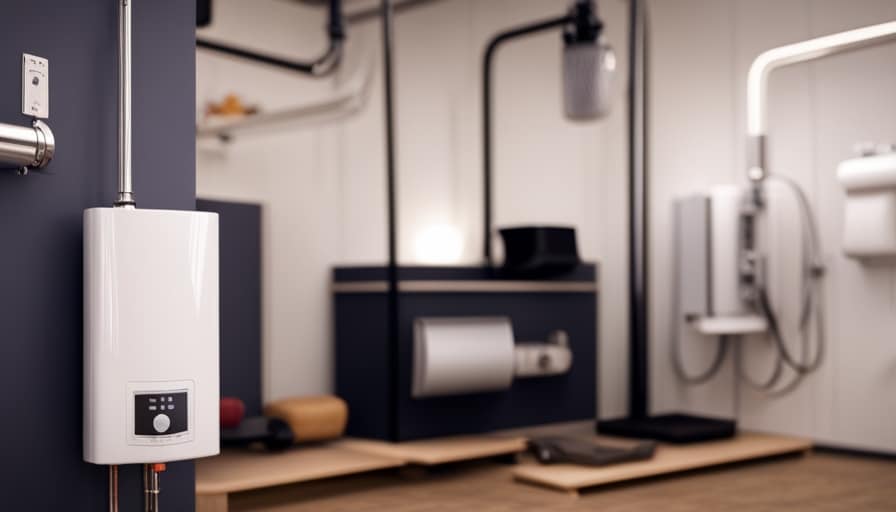
Key Takeaways
- Off-grid systems offer independence, self-sufficiency, and clean energy generation
- Installing a solar system allows for the generation of clean and renewable energy
- Installing a water filtration system ensures clean and safe drinking water
- Propane is a reliable and efficient choice for heating in small spaces
Choosing Your Power Source: Grid or Off-Grid
We’ve made the decision on our power source for our tiny house: off-grid solar panels.
When it comes to choosing a power source for a tiny house, there are two main options to consider: being connected to the grid or going off-grid. Many people opt for off-grid systems because they offer several advantages over relying solely on the grid or a generator.
Firstly, off-grid solar panels provide us with independence and self-sufficiency, allowing us to generate our own clean and renewable energy.
Secondly, we don’t have to worry about power outages or fluctuations in utility prices.
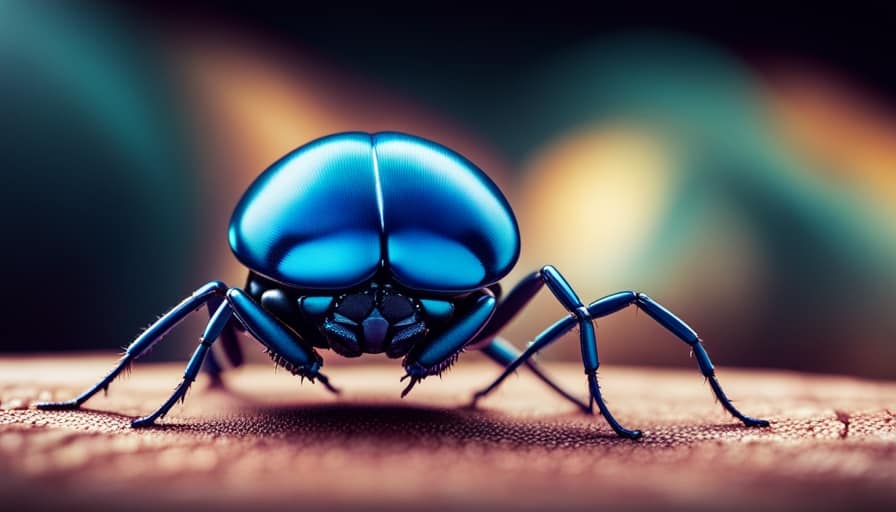
Lastly, off-grid systems are eco-friendly, reducing our carbon footprint. By harnessing the sun, we can tap into its abundant energy and create a sustainable power source for our tiny home.
Now, let’s explore the process of installing a solar system.
Harnessing the Sun: Installing a Solar System
Installing a solar system in our tiny house involves carefully positioning the panels and connecting them to the battery bank. To maximize solar panel efficiency, it’s crucial to install them in an area that receives ample sunlight throughout the day. Ideally, this would be on the roof or in an open space where there’s minimal shade.
Once the panels are installed, they need to be connected to a solar battery storage system. This allows us to store excess energy generated during the day and use it during the night or when the sun isn’t shining. The battery bank should be placed in a cool and well-ventilated area to ensure optimal performance and longevity.
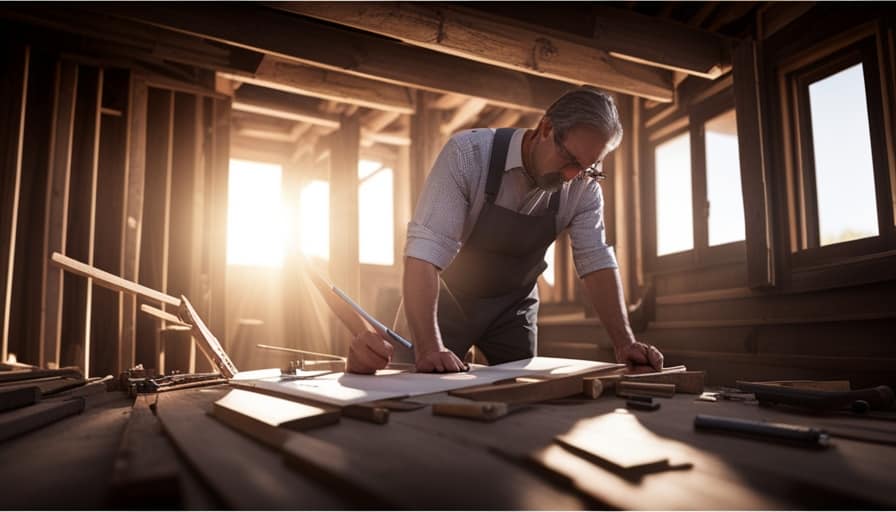
Meeting Your Water Needs: Setting Up a Water Supply
To ensure a reliable water supply, our tiny house needs a well or a connection to a local water source. Here are some practical ways to meet our water needs:
-
Water Filtration: Installing a water filtration system is crucial to ensure clean and safe drinking water. There are various options available, including activated carbon filters, reverse osmosis systems, and UV sterilizers. Choose a filtration system that suits our needs and budget.
-
Rainwater Collection: Harvesting rainwater is an excellent way to reduce our reliance on traditional water sources. Install a rainwater collection system that includes gutters, downspouts, and a storage tank. Use this collected water for non-potable purposes such as watering plants, flushing toilets, and doing laundry.
-
Connection to Local Water Source: If a well isn’t feasible, connecting our tiny house to a local water source is the next best option. Ensure that the connection complies with local regulations and consider installing a water meter to track usage and manage consumption efficiently.
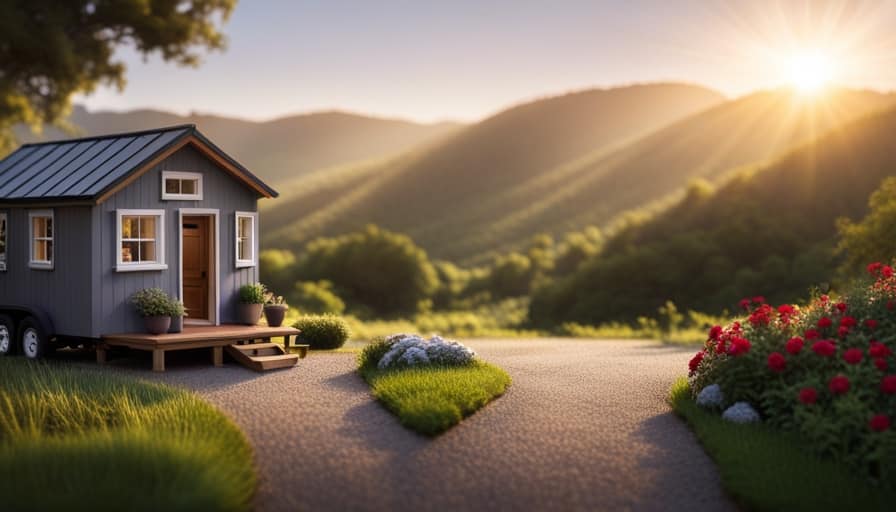
Managing Waste: Installing a Septic System
But before we get into that, let’s talk about managing waste in our tiny house by installing a septic system. Waste management is an important aspect of sustainable living, especially in a compact space. One option for waste disposal in a tiny house is using composting toilets. These toilets separate solid and liquid waste, allowing for the decomposition of organic matter. This process creates nutrient-rich compost that can be used in gardening. Installing a septic system is another viable option. A septic system consists of a tank where waste is collected and treated before being released into the ground. This system requires regular maintenance, such as periodic pumping. Proper waste management is essential for maintaining a clean and healthy living environment in our tiny homes.
| Pros | Cons |
|---|---|
| Sustainable | Regular maintenance required |
| Nutrient-rich compost | Higher initial cost |
| Environmentally friendly | Requires space for installation |
| Reduces water usage |
Keeping Warm and Cooking: Establishing a Propane Setup
Let’s talk about keeping warm and cooking in your tiny house by establishing a propane setup.
When it comes to heating options, propane can be a reliable and efficient choice for small spaces.
Propane offers convenience and flexibility, allowing you to prepare meals without the need for a traditional kitchen setup. Cooking with propane is a great option for tiny house living.
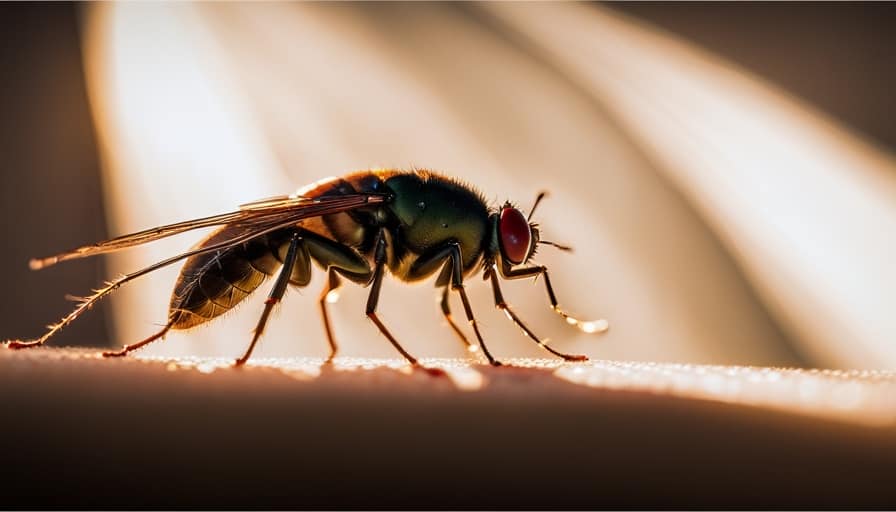
By setting up a propane system in your tiny house, you can easily regulate the temperature and keep your space cozy during colder months.
In addition to heating, propane can also power your stove and oven, providing you with a convenient way to cook your meals.
Having a propane setup in your tiny house allows you to have a fully functional kitchen without the need for extensive plumbing or electrical work.
With a propane system, you can cook all your favorite meals and enjoy the benefits of a traditional kitchen, even in a small space.

Propane Heating Options
We’ve found that using a single propane tank for both heating and cooking is the most efficient option for our tiny house. Propane offers a safe and reliable heating solution, especially in small spaces where electric heating may not be practical.
Here are a few reasons why we prefer propane heating:
-
Cost-effective: Propane is often more affordable than electricity, making it a budget-friendly choice for heating our tiny house.
-
Energy-efficient: Propane heaters are highly efficient, converting a large percentage of fuel into heat. This means we can stay warm without wasting energy.

-
Versatility: Propane can be used for multiple purposes, including heating, cooking, and even powering appliances like refrigerators or water heaters.
Cooking With Propane
We can easily cook with propane in our tiny house by setting up a propane stove and ensuring proper ventilation for safety. Propane stoves are a popular choice for cooking in small spaces due to their compact size and efficient heat output.
To set up a propane stove, you’ll need to connect it to a propane tank using a regulator and hose. Make sure to follow the manufacturer’s instructions and check for any leaks before using the stove.
When cooking with propane, it’s important to practice propane safety by keeping flammable materials away from the stove, never leaving it unattended, and ensuring proper ventilation to prevent carbon monoxide buildup.
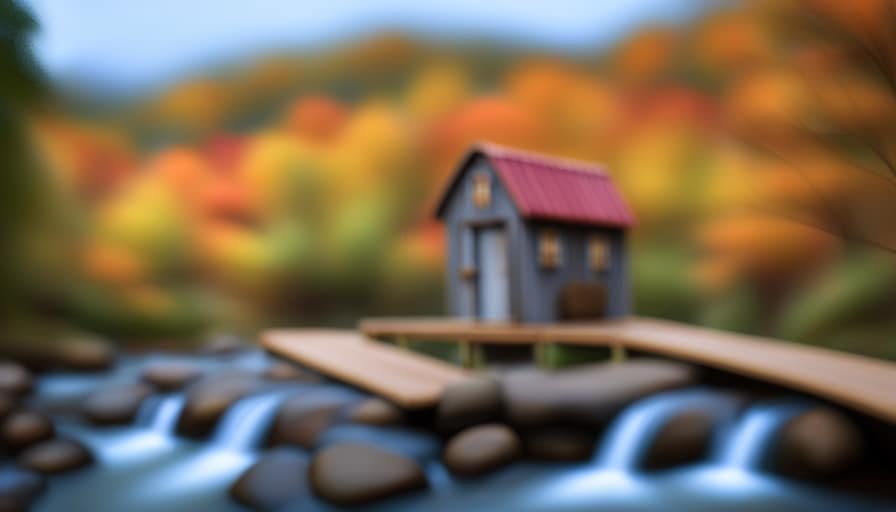
Staying Connected: Installing Internet and Phone Lines
Installing internet and phone lines can be a crucial step in staying connected in our tiny home. To ensure a seamless connection, we started by installing fiber optic cables to optimize our Wi-Fi speed. This allows us to stream movies, video call loved ones, and work remotely without any interruptions.
We strategically placed our Wi-Fi router in a central location to maximize coverage throughout the house. Additionally, we invested in a Wi-Fi extender to reach every corner of our compact home. This ensures that no matter where we are, we can always stay connected.
Frequently Asked Questions
How Much Does It Cost to Switch From a Grid Power Source to an Off-Grid Power Source?
Switching from a grid power source to an off-grid power source involves a cost comparison. We weigh the expenses of installation, maintenance, and equipment for both options. It’s important to consider long-term savings and environmental impact.
Are There Any Government Incentives or Grants Available for Installing a Solar System in a Tiny House?
Yes, there are government incentives available for installing a solar system in a tiny house. These incentives can help offset the initial costs and make the installation more affordable.
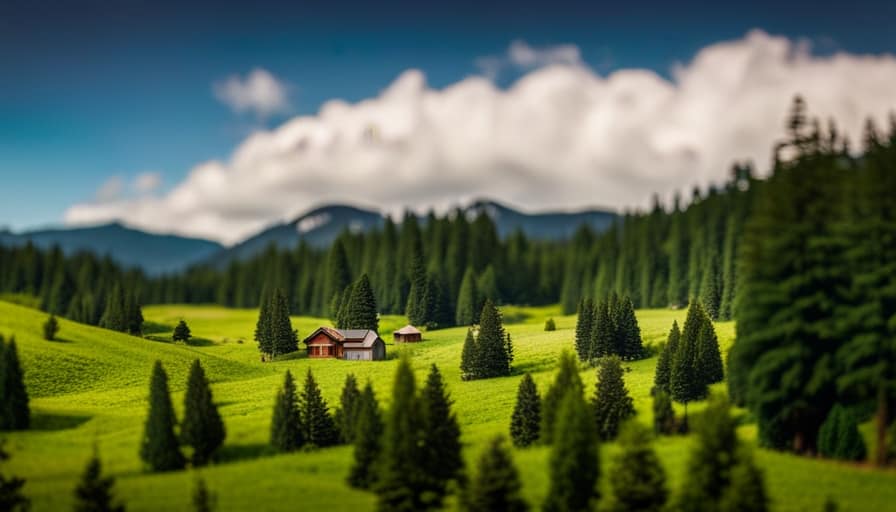
What Are the Maintenance Requirements for a Septic System in a Tiny House?
Maintaining a septic system in a tiny house is crucial. Regular pumping, inspecting pipes, and using septic-safe products are like giving your system a tune-up. It’s a cost-effective way to keep your off-grid power switch running smoothly.
Can I Use an Electric Heating System Instead of a Propane Setup to Keep My Tiny House Warm?
Using an electric heating system instead of propane in a tiny house has pros and cons. Electric is more efficient and easier to install, but it may require a larger electrical system and can be more expensive to operate.
What Are the Options for Internet and Phone Service in Remote Areas Where Tiny Houses Are Typically Located?
In remote areas where tiny houses are typically located, options for internet and phone service providers may be limited. Satellite internet is often the best choice for reliable connectivity in these areas.
Conclusion
In conclusion, by choosing the right power source, harnessing the sun’s energy, setting up a water supply, and installing a septic system, you can create a compact home that’s efficient and functional.

Additionally, establishing a propane setup and installing internet and phone lines can further enhance the functionality and comfort of your tiny house.
These utilities, like a well-oiled machine, work together to brighten your tiny house and make it feel like a cozy haven amidst the hustle and bustle of the world.
I’m Theodore, and I love tiny houses. In fact, I’m the author of Tiny House 43, a book about tiny houses that are also tree houses. I think they’re magical places where imaginations can run wild and adventures are just waiting to happen.
While tree houses are often associated with childhood, they can be the perfect adult retreat. They offer a cozy space to relax and unwind, surrounded by nature. And since they’re typically built on stilts or raised platforms, they offer stunning views that traditional homes simply can’t match.
If you’re looking for a unique and romantic getaway, a tree house tiny house might just be the perfect option.
Tiny Houses
Embrace Minimalism: Mastering Life in a Tiny House
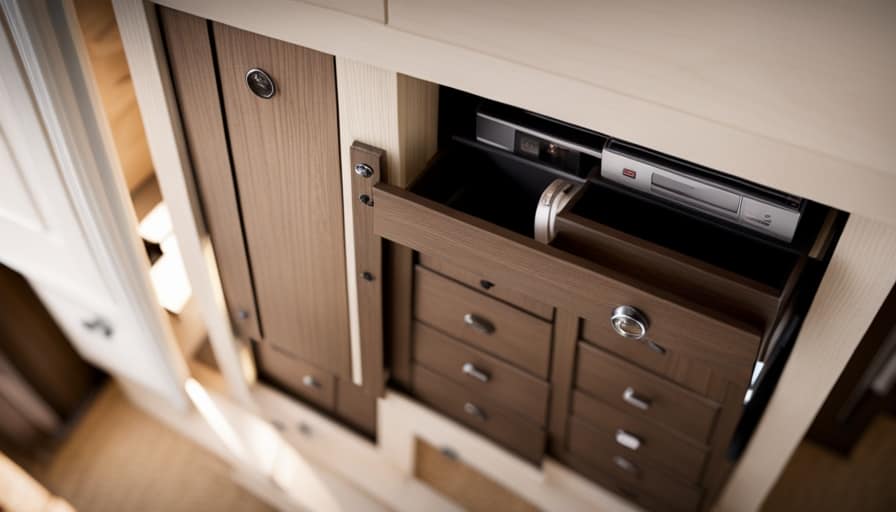
We understand. The idea of living in a tiny house may seem unconventional to some, but hear us out.
Embracing minimalism is not about sacrificing comfort, but rather about mastering life in a small space.
In this article, we’ll show you how to downsize your belongings, organize clever storage solutions, and utilize multipurpose furniture.
From establishing a cleaning routine to managing cooking in a small kitchen, we’ve got you covered.

Get ready to lead a sustainable and fulfilling life in a tiny house.
Key Takeaways
- Assess wardrobe and declutter belongings to embrace a minimalist lifestyle
- Utilize storage solutions and organization techniques to maximize space in a tiny house
- Invest in multipurpose furniture to maximize functionality and save space
- Implement sustainable living practices such as water conservation, composting, and renewable energy usage in a tiny house setting.
Downsizing Belongings
We’ll start by assessing our wardrobe and deciding which clothes to keep and which to donate. Embracing a minimalist lifestyle means decluttering and simplifying our belongings. When it comes to our clothes, it’s important to be intentional and keep only what we truly need and love. Start by sorting through each item and ask yourself if it brings joy or serves a purpose. Be honest with yourself and let go of items that no longer fit or reflect your style. Consider donating gently used clothing to those in need.
Organizing Storage Solutions
When organizing storage solutions in our tiny house, we focus on maximizing space while keeping everything easily accessible. Here are four essential storage solutions and decluttering techniques that have helped us create an organized and functional living space:
-
Utilize vertical space: Install shelves or hanging organizers to make use of the walls and free up valuable floor space.
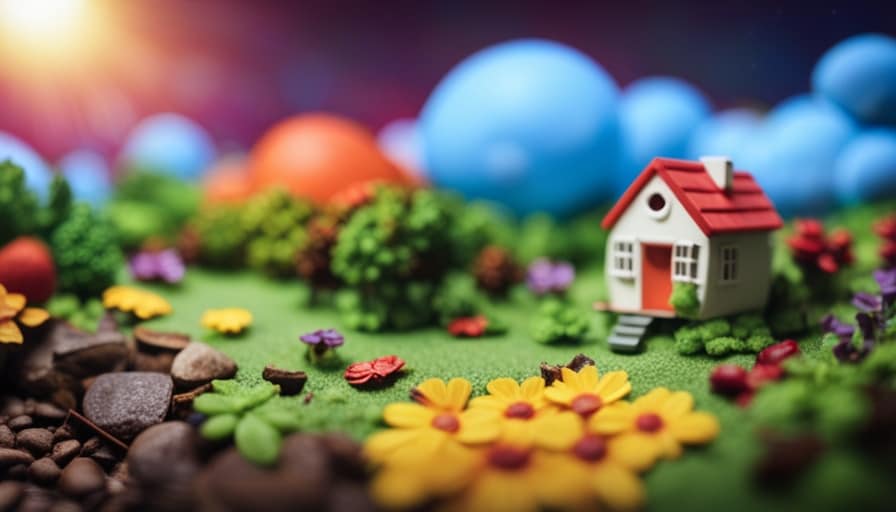
-
Invest in multi-purpose furniture: Look for furniture pieces that serve multiple functions, such as a bed with built-in storage drawers or a coffee table with hidden compartments.
-
Use clear containers for storage: Transparent bins or boxes allow you to easily see what’s inside, making it simpler to find and retrieve items when needed.
-
Implement a ‘one in, one out’ rule: Whenever you bring in a new item, make a commitment to remove something else to maintain a clutter-free environment.
Utilizing Multipurpose Furniture
To make the most of our limited space in the tiny house, we can maximize functionality by utilizing multipurpose furniture. Multi functional decor not only saves space but also adds style and versatility to our living areas. One great way to achieve this is by investing in furniture that serves multiple purposes. For example, a sofa bed can provide seating during the day and transform into a comfortable bed at night. Another option is a coffee table with built-in storage, allowing us to hide away clutter and keep our living area tidy. Additionally, maximizing vertical space is crucial in a tiny house. Consider using bookshelves that reach the ceiling or installing wall-mounted foldable tables for dining. By embracing multipurpose furniture and maximizing vertical space, we can create a functional and stylish living space in our tiny house.
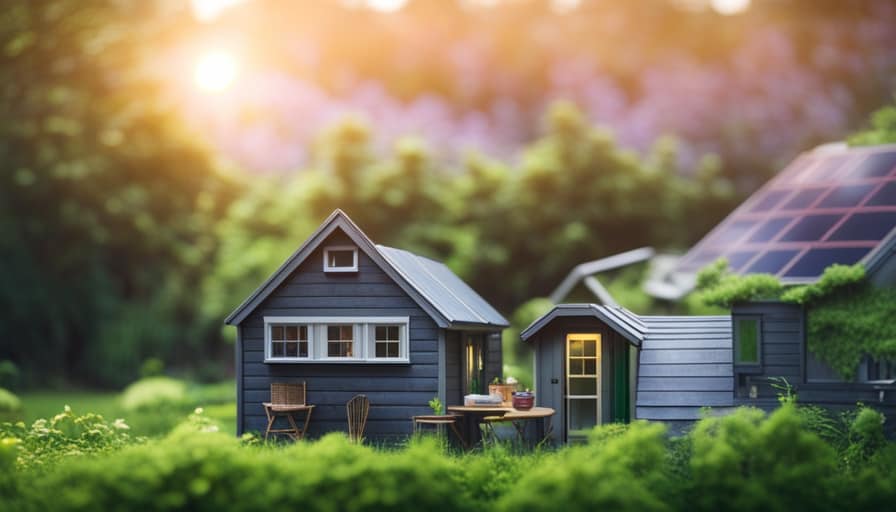
| Furniture | Functionality | Benefits |
|---|---|---|
| Sofa Bed | Seating and Sleeping | Saves space and adds comfort |
| Coffee Table | Storage and Surface | Hides clutter and adds utility |
| Bookshelves | Vertical Storage | Maximizes space and organizes |
| Foldable Table | Dining and Space-saving | Allows flexibility and saves space |
Establishing a Cleaning Routine
Keeping our tiny house clean requires establishing a regular cleaning routine. Here are four steps to help you maintain cleanliness:
-
Create a daily cleaning checklist: Start by making a list of tasks that need to be done every day, such as sweeping the floors, wiping down countertops, and tidying up cluttered areas.
-
Set aside dedicated cleaning time: Designate a specific time each day for cleaning. This could be in the morning before starting your day or in the evening after dinner. Consistency is key.
-
Break up the tasks: Instead of trying to tackle all the cleaning at once, break it up into smaller tasks. For example, clean one room each day or focus on one specific task, like dusting or vacuuming.
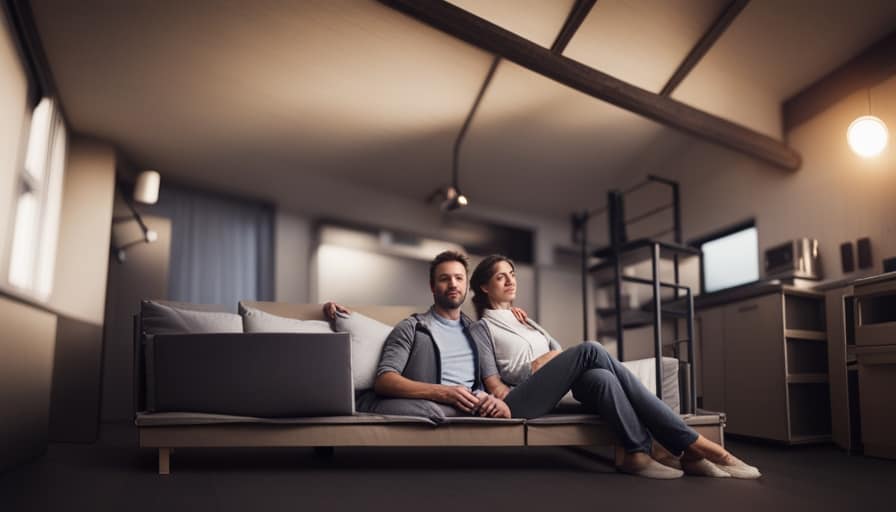
-
Involve the whole family: Cleaning shouldn’t be a one-person job. Encourage everyone in the household to participate in keeping the tiny house clean. Assign specific tasks to each person and work together as a team.
Managing Cooking in a Small Kitchen
When it comes to managing cooking in a small kitchen, we need to get creative with space-saving cooking hacks and efficient kitchen organization.
Maximizing vertical space by using wall-mounted shelves and hooks can free up valuable counter space.
Utilizing multi-purpose kitchen tools and investing in stackable storage containers can also help optimize the limited space in our tiny kitchen.

Space-Saving Cooking Hacks
We love utilizing clever space-saving cooking hacks to manage cooking in our small kitchen. Here are four practical tips that have helped us make the most of our limited space:
-
Maximize storage: Utilize vertical space by installing shelves or hanging racks to store pots, pans, and utensils. Use drawer dividers or organizers to keep small appliances and gadgets neatly arranged.
-
Streamline meal planning: Plan your meals in advance to reduce clutter and make efficient use of limited countertop space. Consider using a meal planning app or creating a weekly menu board to stay organized.
-
Invest in multi-purpose tools: Opt for small appliances that serve multiple functions, such as a blender that can also be used as a food processor. This way, you can save space while still having the necessary tools for various cooking tasks.
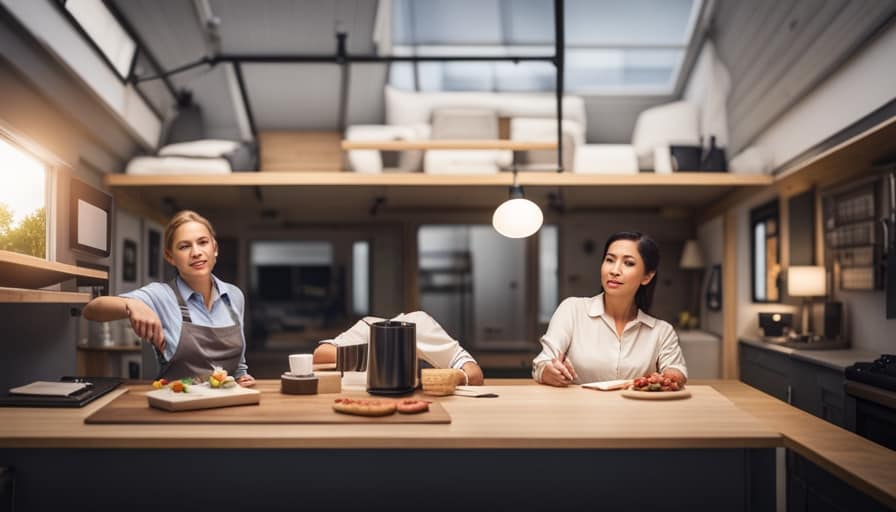
-
Optimize counter space: Keep your countertops clear by using wall-mounted knife racks, magnetic spice containers, or a hanging pot rack. This will free up valuable workspace and make your small kitchen feel more open and functional.
Efficient Kitchen Organization
Let’s tackle the challenge of organizing our small kitchen efficiently to manage cooking in a tiny house. In a limited space, it’s crucial to make the most of every inch.
One way to do this is by using space-saving kitchen gadgets. These clever tools can help you maximize countertop space and keep your kitchen organized. Look for items like collapsible measuring cups, stackable storage containers, and magnetic knife strips. These gadgets can be easily stored away when not in use, freeing up valuable space.
By utilizing these space-saving solutions, you can create a functional and efficient kitchen that allows you to cook with ease in your tiny house.

Now, let’s move on to the next challenge: handling limited water resources.
Handling Limited Water Resources
Our strategy for managing limited water resources in our tiny house involves implementing efficient fixtures and practicing water conservation techniques.
Here are four ways we make the most of our water supply:
-
Low-flow fixtures: By installing low-flow faucets and showerheads, we significantly reduce water usage without sacrificing functionality. These fixtures maintain adequate pressure while conserving water, helping us save gallons each day.
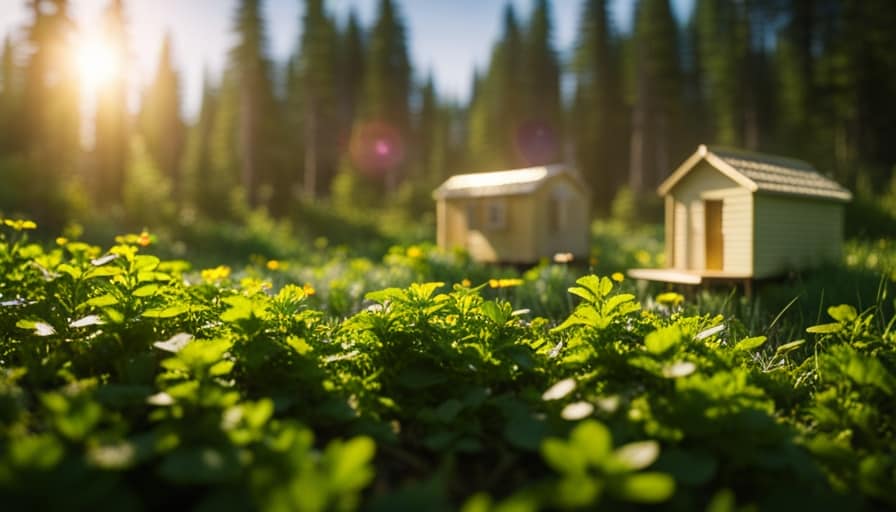
-
Dual-flush toilets: Our toilets have a dual-flush feature, allowing us to choose between a full flush or a half flush, depending on the waste. This feature helps us conserve water by using less for liquid waste.
-
Greywater recycling: We collect and treat greywater from our sinks and showers, filtering and reusing it for non-potable purposes like watering plants or flushing toilets. This practice reduces our reliance on fresh water sources.
-
Rainwater harvesting: We’ve a system in place to collect rainwater from our roof, storing it in tanks for later use. This allows us to utilize natural resources and reduce our dependence on municipal water supplies.
Practicing Waste Composting
One of the ways we can minimize waste in our tiny house is by practicing composting. Waste reduction is key in maintaining a sustainable lifestyle, and composting techniques can help us achieve that goal.

Composting involves the decomposition of organic waste, such as food scraps and yard trimmings, into nutrient-rich soil. By composting our waste, we not only reduce the amount of waste that goes to landfills but also create a valuable resource for our gardens or plants.
To start composting, we can designate a small area in our tiny house or outside for a compost bin. We can then add organic materials like fruit and vegetable peels, coffee grounds, and grass clippings. It’s important to turn the compost regularly to aid in the decomposition process.
Connecting With a Similar Community
Fortunately, there are many opportunities to connect with a similar community of tiny house enthusiasts. Engaging with this community not only provides social support but also offers a wealth of knowledge and inspiration. Here are four ways to connect with fellow tiny house enthusiasts:
-
Join online forums and social media groups dedicated to tiny house living. These platforms allow you to ask questions, share experiences, and learn from others who’ve already embarked on this journey.
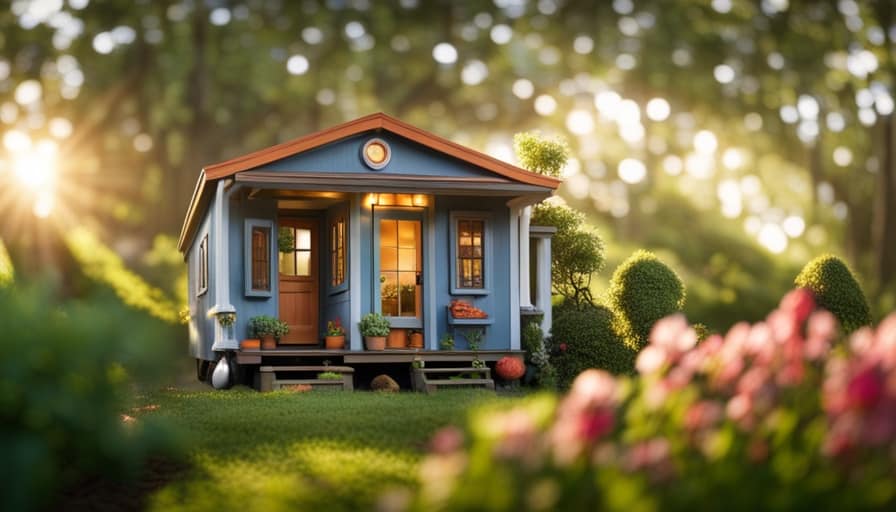
-
Attend tiny house festivals and workshops. These events provide an opportunity to meet like-minded individuals, explore different types of tiny houses, and attend informative sessions on various aspects of tiny house living.
-
Volunteer or participate in community projects related to tiny houses. This community engagement allows you to contribute to the movement while connecting with others who share your passion for sustainable living.
-
Start or join a local tiny house meetup group. These gatherings provide a chance to meet and network with other tiny house enthusiasts in your area.
Leading a Sustainable Life in a Tiny House
Thankfully, by adopting sustainable practices and making conscious choices, we can lead a fulfilling and environmentally-friendly life in a tiny house.
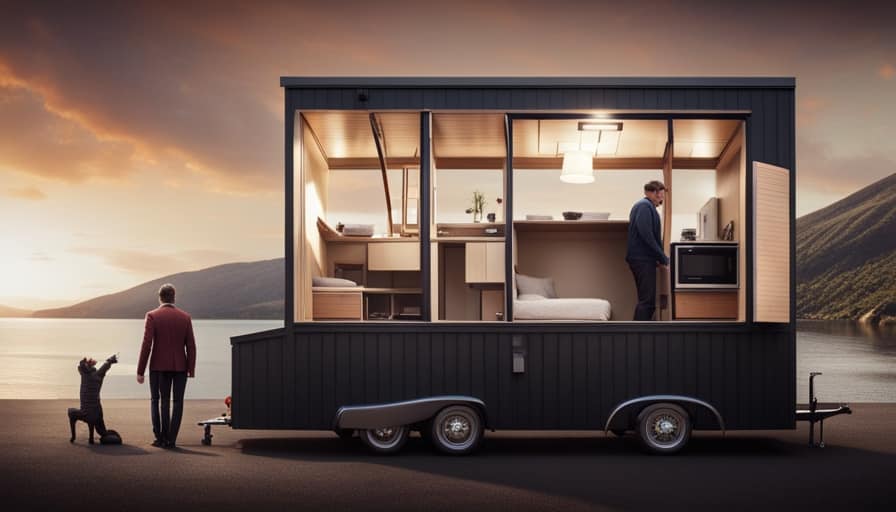
One way to do this is through sustainable gardening. In a tiny house, space is limited, but that doesn’t mean we can’t grow our own food. Vertical gardens and container gardening are great options for maximizing space. By growing our own fruits, vegetables, and herbs, we reduce our carbon footprint and have fresh, organic produce at our fingertips.
Another important aspect of sustainable living in a tiny house is utilizing renewable energy solutions. Solar panels can be installed on the roof, providing electricity for our daily needs. We can also use a composting toilet and collect rainwater for various purposes.
These small adjustments can have a big impact on our ecological footprint and help us lead a more sustainable life in our tiny homes.
Frequently Asked Questions
Can I Still Have a Comfortable and Functional Living Space After Downsizing My Belongings?
Yes, we can definitely have a comfortable and functional living space even after downsizing our belongings. By maximizing functionality and maintaining comfort, we can create a space that serves our needs and brings us joy.

How Can I Optimize the Limited Storage Space in a Tiny House and Keep It Organized?
To optimize limited storage in a tiny house and keep it organized, we use smart storage solutions like multi-functional furniture and vertical storage. We also employ organizing tips for small spaces, such as using bins and labeling everything.
What Are Some Creative Ways to Make the Most Out of Multipurpose Furniture in a Tiny House?
To make the most out of multipurpose furniture in a tiny house, we get creative with storage solutions and maximize vertical space. It’s all about finding furniture that serves multiple functions and can be easily stored away when not in use.
Are There Any Tips for Establishing an Effective Cleaning Routine in Such a Small Living Space?
Simplify daily chores by establishing an effective cleaning routine in our tiny house. We maximize storage space for cleaning supplies, making it easy to keep our space clean and organized.
How Can I Efficiently Manage Cooking in a Small Kitchen With Limited Counter Space and Appliances?
Efficient meal planning and creative cooking hacks are essential in managing cooking in a small kitchen with limited counter space and appliances. We prioritize organization, utilize multi-functional tools, and maximize storage to make the most of our tiny kitchen.
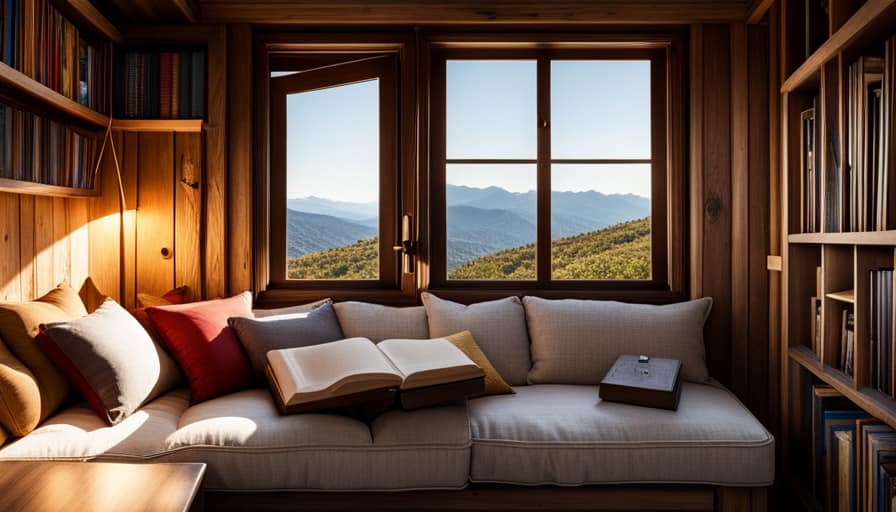
Conclusion
In conclusion, embracing minimalism and mastering life in a tiny house offers a practical and sustainable lifestyle.
Did you know that according to a study by the National Association of Home Builders, the average size of a new single-family home in the US has increased by 62% since the 1970s?
By downsizing our belongings, utilizing multipurpose furniture, and practicing waste composting, we can lead a simpler and more environmentally friendly life.
So why not join the tiny house community and start enjoying the benefits of minimalist living today?

I’m Theodore, and I love tiny houses. In fact, I’m the author of Tiny House 43, a book about tiny houses that are also tree houses. I think they’re magical places where imaginations can run wild and adventures are just waiting to happen.
While tree houses are often associated with childhood, they can be the perfect adult retreat. They offer a cozy space to relax and unwind, surrounded by nature. And since they’re typically built on stilts or raised platforms, they offer stunning views that traditional homes simply can’t match.
If you’re looking for a unique and romantic getaway, a tree house tiny house might just be the perfect option.
-

 Beginners Guides2 weeks ago
Beginners Guides2 weeks agoHow To Buy A Tesla Tiny House
-

 Energy Efficiency2 months ago
Energy Efficiency2 months agoBest Tiny Homes For Cold Climates
-

 Beginners Guides2 weeks ago
Beginners Guides2 weeks agoTiny House Nation Where Are They Now Stephanie
-

 Tiny House Resources (e.g., legalities, cost, insurance, FAQs)2 months ago
Tiny House Resources (e.g., legalities, cost, insurance, FAQs)2 months agoDo Tiny Homes Need Planning Permission?
-

 Beginners Guides3 weeks ago
Beginners Guides3 weeks agoFrom The Show Tiny House Nation How Many Keep Their Tiny House?
-

 Beginners Guides2 months ago
Beginners Guides2 months agoUsing a Climbing Net For Treehouse Construction
-

 Beginners Guides2 months ago
Beginners Guides2 months agoHow to Build a Treehouse Without Drilling Into the Tree
-

 Beginners Guides3 weeks ago
Beginners Guides3 weeks agoTiny House Nation Who Pays For The Houses







